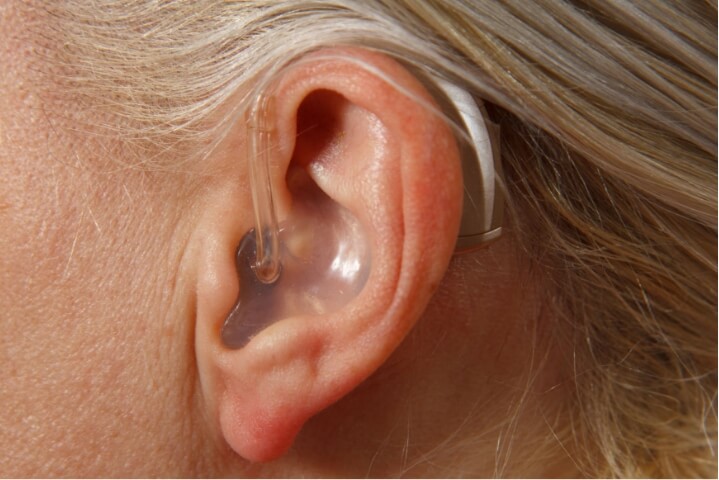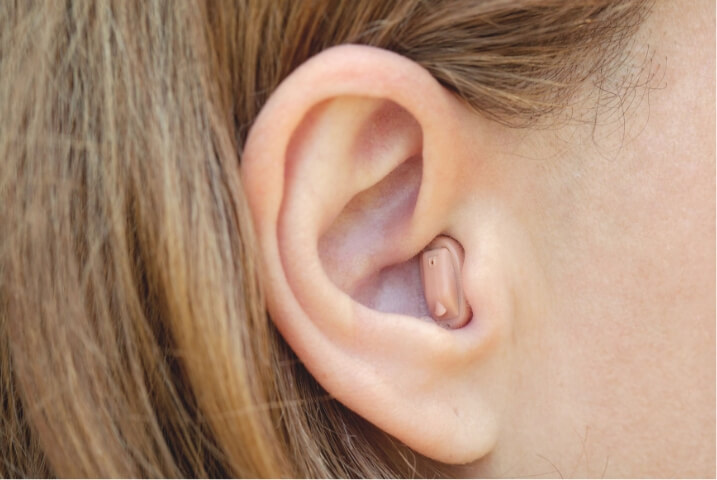Hearing Aids
How do hearing aids work?
A hearing aid has a three-component system which amplifies sound:
Microphone – receives sound and converts it into digital signals
Amplifier – increases the strength of the sound signals and send them into the ear
Receiver/speaker – produces the amplified sound and delivers it into the ear canal.
Different types of hearing aids
What type of hearing aid is best for you? Well, it depends on the severity of your hearing loss, your lifestyle, and style preference. Hearing aids come in a variety of types and styles; all with differences in power, size, and how they function. With continuous technological advancements, hearing aids have come a long way, with some even offering Bluetooth, app-controlled and recharging capabilities. While there are advantages and disadvantages to all styles, rest assured, there is a hearing aid solution to meet your needs.
There are two main categories of hearing aids:

Behind-the-ear hearing aids (BTE)
BTE hearing aids are the most common and sit exactly as the name suggests –behind the ear. Sound is transferred though a thin tube that runs over the top of the ear and inserted into the ear canal. With today’s technological advances, behind-the-ear hearing aids are now much smaller and lightweight, making them more discreet.
BEST FOR:
• All hearing loss levels
• Individuals who experience ear infections and/or excessive ear wax build up
• Children and those individuals with small or narrow ear canals
PROS:
• Comfortable to wear
• Lower maintenance
• Available in different colours to match hair colour
• Ease of use - larger buttons
• Minimal feedback
• Longer battery life – larger/more powerful batteries
• Reprogrammable
• Custom-fit earmould is replaceable
• Offers models that connect wirelessly to devices
CONS:
• Less discreet than other smaller hearing aid types
• Wind noise in open spaces
STYLES OF BEHIND-THE-EAR:
• Receiver-in-the-Ear (RITE)
• Receiver-in-Canal (RIC)

In-the-ear hearing aids (ITE)
ITE hearing aids are custom-made to fit inside the shape of the ear. This hard plastic form encases the electronics and sits in the ear canal, providing a more discreet appearance. Depending on the type of hearing loss, the unit may sit deeper into the ear canal or closer to the outside of the ear bowl.
BEST FOR:
• Suitable for all hearing loss levels, but best for mild or moderate hearing loss
• Eyeglass wearers
• Sport enthusiasts/active lifestyle
PROS:
• Smaller than behind-the-ear styles, but still larger easier to handle than in-the-canal hearing aids
• Available in various skin-tone shades
• Level of sound clarity
• Reduced feedback or interference from wind nose
• Offers models that connect wirelessly to devices
• Level of comfort – nothing behind the ear
• Custom fit
CONS:
• Higher maintenance requirements
• Risk of earwax impaction or infection if not cleaned daily
• Less comfortable for individuals with small or narrow ear canals, such as children
• Not recommended for those prone to chronic ear infections
• Not suitable for individuals with dexterity issues
STYLES OF IN-THE-EAR:
• Invisible In-the-Canal (IIC)
• Completely-in-Canal (CIC)
• In-the-Canal (ITC)
Invisible In The Canal (IIC)
- Bluetooth connectivity
- Easy to adjust volume and program
- Exchangeable battery
- Rechargeable battery
- Long battery life
- Mild to moderate hearing loss
- Severe hearing loss
- Profound hearing loss
Completely In The Canal (CIC)
- Bluetooth connectivity
- Easy to adjust volume and program
- Exchangeable battery
- Rechargeable battery
- Long battery life
- Mild to moderate hearing loss
- Severe hearing loss
- Profound hearing loss
In The Canal (ITC)
- Bluetooth connectivity
- Easy to adjust volume and program
- Exchangeable battery
- Rechargeable battery
- Long battery life
- Mild to moderate hearing loss
- Severe hearing loss
- Profound hearing loss
In The Ear (ITE) (Full Shell/Half Shell)
- Bluetooth connectivity
- Easy to adjust volume and program
- Exchangeable battery
- Rechargeable battery
- Long battery life
- Mild to moderate hearing loss
- Severe hearing loss
- Profound hearing loss
Receiver In The Canal (RIC) (R)
- Bluetooth connectivity
- Easy to adjust volume and program
- Exchangeable battery
- Rechargeable battery
- Long battery life
- Mild to moderate hearing loss
- Severe hearing loss
- Profound hearing loss
Behind The Ear (BTE) (R)
- Bluetooth connectivity
- Easy to adjust volume and program
- Exchangeable battery
- Rechargeable battery
- Long battery life
- Mild to moderate hearing loss
- Severe hearing loss
- Profound hearing loss


